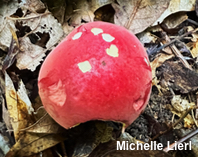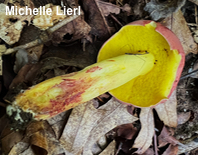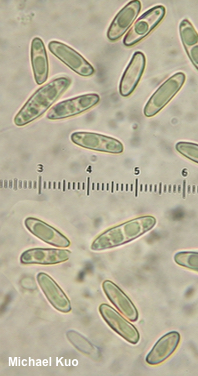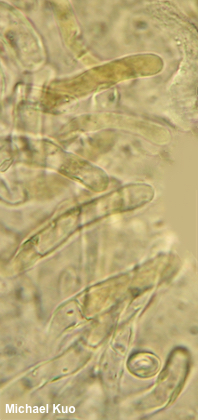| Major Groups > Boletes > Boletus roodyi |

|
[ Basidiomycota > Boletales > Boletaceae > Boletus . . . ] Boletus roodyi by Michael Kuo, 7 March 2024 To my knowledge this is the only red-capped, yellow-pored bolete in North America that does not stain blue on the bruised pore surface, the sliced flesh, or both. Boletus roodyi is a mycorrhizal associate of oaks, found east of the Great Plains in summer and fall. It has many look-alikes that do stain blue (Boletus bicolor, Boletus harrisonii, and Xerocomellus rubellus are a few), but the lack of staining ought to successfully separate Boletus roodyi. The collection featured here differs from the original description of Boletus roodyi (Ortiz-Santana et al. 2009) in its somewhat yellower flesh and its chemical reactions. Ortiz-Santana describes collections made primarily by Bill Roody and David Lewis that feature a flash of grayish blue when KOH or ammonia is applied to the cap surface; the specimen described here did not flash blue. Thanks to Michelle Lierl for collecting, documenting, and preserving Boletus roodyi for study; her collection is deposited in The Herbarium of Michael Kuo.. Description: Ecology: Mycorrhizal with oaks; growing alone, scattered, or gregariously; summer and fall; originally described from West Virginia (Ortiz-Santana et al. 2009); recorded from Texas to Florida and Massachusetts; possibly widely distributed east of the Great Plains. The illustrated and described collection is from Indiana. Note: A single, fairly young specimen is described here. Cap: 5 cm; convex; dry; very finely velvety; bright pinkish red; with a tiny sterile overhanging margin. Pore Surface: Bright yellow; not bruising; 1–2 pores per mm; tubes to 8 mm deep. Stem: 6 cm long; 1 cm thick at apex; 2–3 cm thick at base; tapered to apex; solid; dry; bright yellow apically, flecked with red over the lower portion; not reticulate; basal mycelium whitish. Flesh: Yellow; not staining on exposure. Odor and Taste: Not distinctive when fresh; dried specimens with a vanilla odor. Chemical Reactions: KOH orangish yellow on cap; ammonia orangish yellow on cap (but see discussion above). Spore Print: Olive brown. Microscopic Features: Spores 10–15 x 2.5–4 µm; boletoid-fusiform; smooth; yellowish in KOH; inamyloid. Basidia about 25 x 5 µm; clavate; 4-sterigmate. Hymenial cystidia scarcely projecting; 25–35 x 5–7.5 µm; fusiform to lageniform; smooth; thin-walled; hyaline in KOH. Pileipellis a collapsing trichoderm; elements 4–6 µm wide, smooth, septate, hyaline to golden in KOH; terminal cells with rounded apices. REFERENCES: B. Ortiz-Santana, D. P. Lewis & E. E. Both, 2009. (Bessette et al., 2000 [NAB-16]; Bessette et al., 2016.) Herb. Kuo 09092301. This site contains no information about the edibility or toxicity of mushrooms. |
© MushroomExpert.Com |
|
Cite this page as: Kuo, M. (2024, March). Boletus roodyi. Retrieved from the MushroomExpert.Com Web site: http://www.mushroomexpert.com/boletus_roodyi.html |



